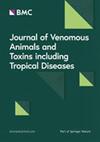Pinching or stinging? Comparing prey capture among scorpions with contrasting morphologies
IF 1.8
3区 医学
Q4 TOXICOLOGY
Journal of Venomous Animals and Toxins Including Tropical Diseases
Pub Date : 2022-04-01
DOI:10.1590/1678-9199-JVATITD-2021-0037
引用次数: 1
Abstract
Abstract Background: Scorpions can use their pincers and/or stingers to subdue and immobilize their prey. A scorpion can thus choose between strategies involving force or venom, or both, depending on what is required to subdue its prey. Scorpions vary greatly in the size and strength of their pincers, and in the efficacy of their venom. Whether this variability is driven by their defensive or prey incapacitation functionis unknown. In this study, we test if scorpion species with different pincer morphologies and venom efficacies use these weapons differently during prey subjugation. To that end, we observed Opisthacanthus elatus and Chactas sp. with large pincers and Centruroides edwardsii and Tityus sp. with slender pincers. Methods: The scorpion pinch force was measured, and behavioral experiments were performed with hard and soft prey (Blaptica dubia and Acheta domesticus). Stinger use, sting frequency and immobilization time were measured. Results: We found that scorpions with large pincers such as O. elatus produce more force and use the stinger less, mostly subjugating prey by crushing them with the pincers. In C. edwardsii and Tityus sp. we found they use their slender and relatively weak pincers for holding the prey, but seem to predominantly use the stinger to subjugate them. On the other hand, Chactas sp. uses both strategies although it has a high pinch force. Conclusions: Our results show that scorpionspecies with massive pincers and high pinch force as O. elatus use the stinger less for prey subjugation than scorpionspecies with slenderpincers.掐还是刺?比较不同形态的蝎子捕获的猎物
背景:蝎子可以使用它们的钳子和/或毒刺来制服和固定它们的猎物。因此,蝎子可以选择使用武力或毒液的策略,或两者兼而有之,这取决于征服猎物所需的手段。蝎子在钳的大小和力量以及毒液的功效方面差别很大。这种变化是由它们的防御功能还是猎物的失能功能驱动的尚不清楚。在这项研究中,我们测试了不同种类的蝎子在征服猎物时是否使用不同的钳子形态和毒液效果。为此,我们观察到了钳子较大的Opisthacanthus elatus和Chactas sp.以及钳子较细的Centruroides edwardsii和Tityus sp.。方法:测定蝎子的夹力,并对硬、软猎物(Blaptica dubia和Acheta domesticus)进行行为学实验。测定刺针使用、刺针频率和固定时间。结果:我们发现大钳蝎(如大钳蝎)产生的力量更大,使用毒刺的次数更少,主要是通过用钳压碎猎物来征服猎物。在C. edwardsii和Tityus sp.中,我们发现它们使用细长且相对较弱的钳子来抓住猎物,但似乎主要使用毒刺来征服猎物。另一方面,Chactas sp.使用两种策略,虽然它有一个高捏力。结论:钳子大、钳子力大的蝎类比钳子细的蝎类更少使用毒刺征服猎物。
本文章由计算机程序翻译,如有差异,请以英文原文为准。
求助全文
约1分钟内获得全文
求助全文
来源期刊
CiteScore
4.80
自引率
8.30%
发文量
39
审稿时长
6-12 weeks
期刊介绍:
Journal of Venomous Animals and Toxins including Tropical Diseases (JVATiTD) is a non-commercial academic open access publication dedicated to research on all aspects of toxinology, venomous animals and tropical diseases. Its interdisciplinary content includes original scientific articles covering research on toxins derived from animals, plants and microorganisms. Topics of interest include, but are not limited to:systematics and morphology of venomous animals;physiology, biochemistry, pharmacology and immunology of toxins;epidemiology, clinical aspects and treatment of envenoming by different animals, plants and microorganisms;development and evaluation of antivenoms and toxin-derivative products;epidemiology, clinical aspects and treatment of tropical diseases (caused by virus, bacteria, algae, fungi and parasites) including the neglected tropical diseases (NTDs) defined by the World Health Organization.

 求助内容:
求助内容: 应助结果提醒方式:
应助结果提醒方式:


